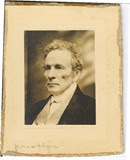James married Sarah Elizabeth Ellison in September of 1806. Together James and Sarah successfully had nine kids together. Besides banking James also was involved in the shipping industry. He had a large fleet of sailing vessels which transported goods along the east coast.
Although James worked as a merchant and with shipping, those were not his main sources of income. in 1818 he created a Hardware firm called James Adger & Company which made him enough money he didn't even know what to do with it. Soon after Adger combined companies with James black which greatly increased the value of the company. By 1850 James Adger was estimated to own $200,000 in real estate and eighteen slaves.
 |
An Article on James Adger's steamship line. |
James Adger was also involved in politics. He used his wealth and power to try and sway the movements in Charleston. He represented Charleston within the House of Representatives for a single term in 1826-1828. He used his political power all for helping himself and his companies flourish.
 |
James's very large headstone at the church |
James Adger the second died at 80 years old in 1858. He died in New York but was returned to Charleston to be buried. He was Buried at the 2nd presbyterian church next to his wife. He lived a very long life, and a successful life and his money is still within his family today.












































